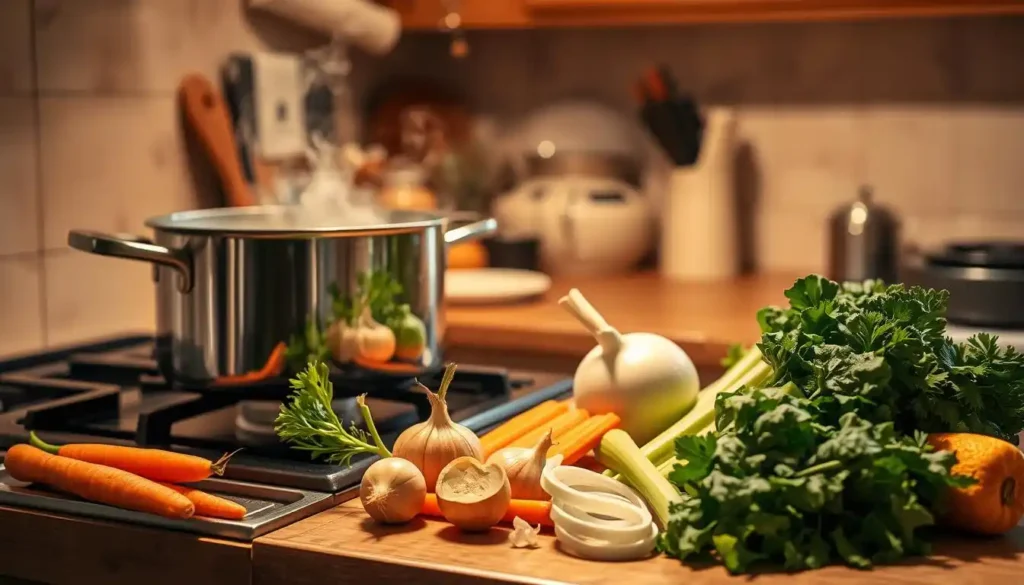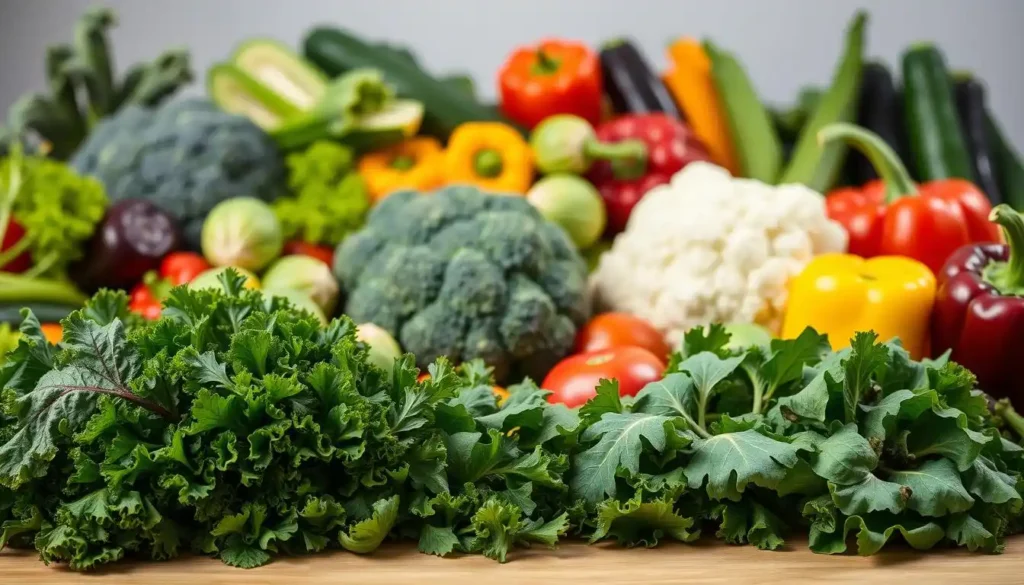Managing diabetes can be tough, but the right foods can help a lot. Nutritious soups are great, offering comfort and energy. They’re also flexible, letting you adjust ingredients to fit your diet.
There are many healthy soup recipes that taste good and are full of nutrients. These soups can help control blood sugar and keep you energized all day. By picking the right ingredients, you can make diabetic soup recipes that are both healthy and tasty.
Table of Contents
Key Takeaways
- Soups can be a comforting and energizing part of a diabetic diet.
- Nutritious soups offer versatility in meal planning.
- Healthy soup recipes can be tailored to manage blood sugar levels.
- Incorporating the right ingredients is key to creating diabetic-friendly soups.
- Nourishing soups can provide sustained energy throughout the day.
Understanding Diabetes and Dietary Needs
Managing diabetes means knowing how food affects your blood sugar. It’s key to understand how different foods impact your health.
Diabetes is a long-term condition where your blood sugar is too high. It happens when your body can’t make enough insulin or use it well. Insulin helps your cells take glucose from your blood for energy.
How Food Affects Blood Sugar Levels
The food you eat directly affects your blood sugar. Carbs are broken down into glucose, raising your blood sugar. The glycemic index (GI) shows how carbs raise blood sugar. Foods with a high GI raise it quickly.

The Importance of Balanced Nutrition
Eating a balanced diet is vital for diabetes management. It keeps your blood sugar in check, supports your health, and helps with weight control. A good meal plan includes lots of whole foods like veggies, fruits, whole grains, lean proteins, and healthy fats.
| Nutrient | Importance for Diabetics | Food Sources |
|---|---|---|
| Carbohydrates | Primary source of energy; choose complex carbs | Whole grains, vegetables, fruits |
| Protein | Helps regulate blood sugar and provides satiety | Lean meats, fish, eggs, legumes |
| Healthy Fats | Supports heart health and provides energy | Nuts, seeds, avocados, olive oil |
Why Soups Are Ideal for Diabetic Meal Plans
Soups can be a big help in managing blood sugar levels. They are a great way to eat a variety of vegetables, lean proteins, and healthy fats. This makes them a key part of a diabetic meal plan.
Nutritional Benefits of Soup-Based Meals
Soups are full of nutrients. By using different vegetables, you can make low-carb soups that are high in fiber and antioxidants. Adding lean proteins like chicken, turkey, or beans makes your soup even better for controlling blood sugar.
Choosing broth-based soups over cream-based ones cuts down on calories and carbs. This makes them a better choice for diabetics. Adding healthy fats like olive oil or avocado boosts the nutritional value of your soups.

Portion Control and Satiety Advantages
Soups are great for controlling how much you eat. Eating a filling, low-calorie soup before a meal can help you eat less overall. This is good for managing blood sugar and weight.
The water in soups also helps you feel full longer. This is especially helpful for people with diabetes who need to watch their carb intake and stay at a healthy weight.
| Benefits | Description |
|---|---|
| Nutritional Value | Soups can be packed with vegetables, lean proteins, and healthy fats. |
| Portion Control | Soups help in controlling the amount of food consumed. |
| Satiety | The high water content in soups contributes to feeling fuller for longer. |
Essential Ingredients for Blood Sugar-Friendly Soups
To make soups good for your blood sugar, pick the right ingredients. You have many options for tasty and healthy soups that help with diabetes. It’s important to know which ingredients are best for your health.
When making diabetic soups, choose your vegetables wisely. Low-glycemic vegetables are great because they don’t raise blood sugar much.
Low-Glycemic Vegetables to Include
Low-glycemic veggies are full of fiber, vitamins, and minerals. They’re healthy and filling. Good choices are spinach, kale, broccoli, cauliflower, and bell peppers. These veggies are low in carbs but high in antioxidants and nutrients.
You can also add carrots, celery, and onions. They’re tasty and full of fiber and nutrients.

Protein Sources for Sustained Energy
Protein is key in blood sugar-friendly soups. It slows down carb digestion, which helps keep blood sugar stable. Good protein sources are lean meats like chicken, turkey, and fish. Also, legumes like lentils, chickpeas, and black beans are great.
These protein sources make soups tasty and give you energy all day.
Healthy Fats and Their Role
Healthy fats are vital in diabetic nutrition. They slow down food digestion, which lowers blood glucose spikes. Good fats include olive oil, avocado, nuts, and seeds. Adding these to your soups boosts their nutrition and makes them more filling.
By using low-glycemic veggies, protein, and healthy fats in your soups, you make meals that are tasty and support your diabetes management.
Hearty Vegetable Diabetic Soup Recipes
Diabetics can enjoy many vegetable soups, which are tasty and healthy. These soups help manage blood sugar and keep you healthy.
Garden Vegetable Minestrone
Garden Vegetable Minestrone is a tasty Italian soup. It’s full of beans, tomatoes, and greens. This makes it rich in fiber and vitamins.
- 1 cup dried kidney beans, soaked overnight and drained
- 2 cups vegetable broth
- 1 can diced tomatoes
- 1 cup chopped fresh spinach
- 1 cup sliced carrots
- 1 cup sliced zucchini
- 1 small onion, chopped
- 3 cloves garlic, minced
- 1 teaspoon dried basil
- 1 teaspoon dried oregano
Start by boiling the soaked kidney beans, broth, tomatoes, onion, and garlic. Then, simmer for 20 minutes. Add carrots and zucchini for another 10 minutes. Finish with spinach and seasonings.
Roasted Cauliflower and Garlic Soup
Roasted Cauliflower and Garlic Soup is creamy and flavorful. Roasting the cauliflower and garlic enhances their sweetness. This complements the soup’s savory taste.
| Ingredients | Quantity |
|---|---|
| 1 head cauliflower | 1 |
| 3 cloves garlic | 3 |
| 2 tablespoons olive oil | 2 |
| 4 cups vegetable broth | 4 |
| 1/2 cup low-fat cream | 1/2 |
Preheat your oven to 425°F (220°C). Toss cauliflower and garlic with olive oil. Roast for 25-30 minutes. Blend with broth and cream for a creamy soup.
Broccoli and Spinach Detox Soup
Broccoli and Spinach Detox Soup is packed with nutrients. It’s full of antioxidants and fiber. This soup supports health and well-being.
- 2 cups broccoli florets
- 1 cup fresh spinach
- 1 small onion, chopped
- 3 cloves garlic, minced
- 4 cups vegetable broth
- 1/2 cup low-fat cream
Sauté the onion and garlic. Add broccoli and broth, then boil. Simmer until broccoli is tender. Add spinach and blend with cream for creaminess.
These vegetable soups are delicious and healthy for diabetics. They offer many health benefits. Adding them to your diet can help manage blood sugar and support overall health.
Protein-Packed Soup Options for Stable Blood Sugar
For those with diabetes, protein-rich soups are a great choice. They offer the nutrients needed while keeping blood sugar stable. Adding these soups to your diet can help keep your energy up all day.
These soups are not just tasty but also good for your health, especially if you have diabetes. They help control hunger and give you important nutrients without raising blood sugar.
Chicken and Vegetable Soup with Herbs
Chicken and vegetable soup is a comforting choice for diabetics. Using herbs for flavor instead of salt and sugar makes it healthy and delicious. The chicken adds protein, while the veggies provide vitamins and minerals.
To make it, use lean chicken breast and a mix of colorful veggies like carrots, bell peppers, and spinach. Add herbs like thyme and rosemary for flavor. This soup is not only filling but also helps keep blood sugar stable.
Lentil and Turkey Soup
Lentil and turkey soup is another good choice for diabetics. Lentils are full of fiber and protein, while turkey is lean. Together, they make a nutritious and filling soup that helps manage blood sugar.
Make this soup by cooking lentils with diced turkey breast, onions, and celery. Season with low-sodium broth and spices. It’s a hearty, healthy meal that’s good for your overall health.
Seafood Chowder with Reduced Carbs
Seafood chowder can be made low in carbs, making it perfect for diabetic diets. Use shrimp, cod, and mussels, and reduce or replace potatoes with lower-carb options. This way, you can enjoy a tasty, blood sugar-friendly soup.
Make it creamy with low-fat cream or coconut milk, and add herbs and spices for flavor. This chowder is a nutritious, satisfying choice that supports stable blood sugar levels.
Adapting Traditional Soup Recipes for Diabetic Needs
You can still enjoy your favorite soups even with diabetes. Just make a few changes to keep the taste good and your diet on track. This means swapping out ingredients to keep your meals tasty without harming your health.
Finding the right substitutes for high-carb foods is key. This helps control blood sugar and keeps your meals tasty and fulfilling.
Substitution Strategies for High-Carb Ingredients
Start by swapping out high-carb foods for lower-carb ones. For example, use cauliflower or turnips instead of potatoes. Also, choose vegetable broth over creamy soups to cut down on carbs.
- Replace potatoes with cauliflower or turnips.
- Use vegetable broth instead of creamy bases.
- Opt for lean protein sources like chicken or turkey.
Flavor Enhancement Without Added Sugars
It’s important to make soups taste great without adding sugar. Use herbs and spices to do this. A little cumin or smoked paprika can make a big difference in flavor.
- Use herbs like thyme, rosemary, or parsley.
- Incorporate spices such as cumin, paprika, or cayenne pepper.
- Experiment with citrus juice or vinegar for added depth.
With these tips, you can make many tasty soups that are good for your health. Enjoy exploring new flavors and recipes that fit your diabetic meal plan.
Seasonal Diabetic Soup Recipes for Year-Round Enjoyment
Seasonal soups make your diabetic diet fun and varied all year. They use fresh ingredients to create tasty soups that help control blood sugar.
Summer Cooling Options
In summer, cool soups are perfect for hot days. Here are some great ones:
- Cold cucumber soup with cucumbers, yogurt, and dill.
- Gazpacho, a Spanish soup with tomatoes, peppers, and cucumbers.
- Avocado soup with ripe avocados, lime, and broth.
These soups are refreshing and full of nutrients. They keep you cool and satisfied in summer.
Winter Warming Favorites
In winter, warm soups offer comfort and energy. Here are some favorites:
- Butternut squash soup, rich in vitamins and fiber, from roasted squash and broth.
- Lentil soup, high in protein and fiber, with lentils, veggies, and spices.
- Chicken noodle soup, a classic, with chicken, veggies, and whole-grain noodles.
These soups are tasty and help keep blood sugar stable. They give you energy all day.
| Season | Soup Recipe | Key Ingredients |
|---|---|---|
| Summer | Cold Cucumber Soup | Cucumbers, yogurt, dill |
| Summer | Gazpacho | Tomatoes, peppers, cucumbers |
| Winter | Butternut Squash Soup | Butternut squash, chicken or vegetable broth |
| Winter | Lentil Soup | Lentils, vegetables, spices |
Adding these seasonal soups to your diet keeps meals interesting. You get to enjoy different flavors all year. Whether it’s a cool summer soup or a warm winter one, there’s a healthy option for every season.
Meal Prep and Storage Tips for Diabetic Soups
Meal prep can make diabetic meal planning easier. Preparing soups ahead saves time and keeps your diet consistent. This is key for managing blood sugar.
Batch cooking is a smart way to make diabetic soups. Cooking big batches lets you portion out meals for the week. This way, you always have healthy, diabetic-friendly options.
Batch Cooking Strategies
Start by picking a day to cook in bulk. Choose several diabetic soup recipes that freeze well. Soups like minestrone or lentil soup work great for batch cooking.
- Get all ingredients ready before cooking to make it faster.
- Cook in large pots, then divide into individual containers.
- Mark containers with date and contents to use oldest first.
Freezing and Reheating Methods
Freezing is a great way to keep soups fresh. Use airtight containers to avoid freezer burn. Glass containers or freezer bags work well.
Reheating must be done right to keep the soup’s nutrients and texture. Heat it to at least 165°F (74°C) for safety.
Portion Control Techniques
Controlling portions is crucial in diabetic meal planning. Divide soups into individual servings to avoid overeating. This helps keep blood sugar stable.
A registered dietitian said, “Portion control is not about cutting out food; it’s about balance.” By managing portions, you can enjoy your favorite soups while managing diabetes.
Using these meal prep and storage tips can make your diabetic meal planning easier. You’ll enjoy a variety of healthy, tasty soups while keeping your blood sugar in check.
Conclusion: Incorporating Soup into Your Balanced Diabetic Lifestyle
Adding nutritious soups to your diet can really help with diabetes management. Diabetic soup recipes are tasty and healthy, making them a great choice for a balanced lifestyle. They can help keep your blood sugar levels in check.
There are many diabetic soup recipes to try, from veggie soups to protein-rich ones. Adding these soups to your meals can bring many benefits. It’s a great way to manage your diabetes while enjoying delicious food.
When making your soups, choose low-glycemic veggies, lean proteins, and healthy fats. This way, you’ll get a meal that’s not only tasty but also good for you. With these tips, you’re on the right path to a balanced diabetic lifestyle.
FAQ
What are the best vegetables to use in diabetic soups?
Choose low-glycemic veggies like broccoli, cauliflower, spinach, and bell peppers. They’re full of fiber and antioxidants. This makes them great for managing blood sugar.
Can I use canned beans in my diabetic soup recipes?
Yes, canned beans are okay. Just pick low-sodium ones and rinse them to remove salt and sugar. Beans are packed with protein and fiber.
How can I make my soups more filling and satisfying?
Add protein like chicken, turkey, lentils, or tofu. Also, include healthy fats from avocado or olive oil. This will make your soups more filling and help with portion control.
Are there any specific spices or herbs that can help lower blood sugar levels?
Yes, spices like cinnamon, turmeric, and ginger might help lower blood sugar. They’re great additions to your diabetic soups.
Can I freeze and reheat my diabetic soups?
Yes, you can freeze and reheat your soups. Use airtight containers or freezer bags to avoid freezer burn. Reheat to 165°F (74°C) for food safety.
How can I adapt traditional soup recipes to make them diabetic-friendly?
Swap high-carb ingredients for low-carb ones. Cut down on added sugars. Use herbs and spices for flavor instead of salt and sugar.
What are some tips for meal prep and storage of diabetic soups?
Use batch cooking, portion control, and proper freezing and reheating. This makes meal prep and storage easy and safe.
Can soups be a part of a balanced diabetic diet?
Yes, soups can be a nutritious part of a diabetic diet. They offer vitamins, minerals, and fiber. They also help with portion control and feeling full.

